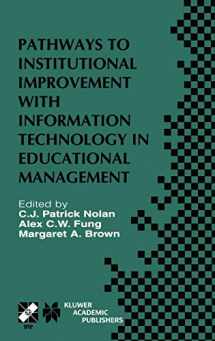
Pathways to Institutional Improvement with Information Technology in Educational Management: IFIP TC3/WG3.7 Fourth International Working Conference on ... Information and Communication Technology, 71)
ISBN-13:
9780792374930
ISBN-10:
0792374932
Edition:
2001
Author:
Margaret Brown, C.J. Patrick Nolan, A. Fung
Publication date:
2001
Publisher:
Springer
Format:
Hardcover
184 pages
FREE US shipping
Book details
ISBN-13:
9780792374930
ISBN-10:
0792374932
Edition:
2001
Author:
Margaret Brown, C.J. Patrick Nolan, A. Fung
Publication date:
2001
Publisher:
Springer
Format:
Hardcover
184 pages
Summary
Pathways to Institutional Improvement with Information Technology in Educational Management: IFIP TC3/WG3.7 Fourth International Working Conference on ... Information and Communication Technology, 71) (ISBN-13: 9780792374930 and ISBN-10: 0792374932), written by authors
Margaret Brown, C.J. Patrick Nolan, A. Fung, was published by Springer in 2001.
With an overall rating of 4.0 stars, it's a notable title among other
Information Management
(Processes & Infrastructure, Education & Reference, Data Mining, Databases & Big Data, Web Design, Web Development & Design, User Experience & Usability, Management & Leadership) books. You can easily purchase or rent Pathways to Institutional Improvement with Information Technology in Educational Management: IFIP TC3/WG3.7 Fourth International Working Conference on ... Information and Communication Technology, 71) (Hardcover) from BooksRun,
along with many other new and used
Information Management
books
and textbooks.
And, if you're looking to sell your copy, our current buyback offer is $0.3.
Description
New Zealand schools have experienced unprecedented change during the lastdecade. Radicalrestructuringoftheframeworksforbothcurriculumand qualificationsfollowedamovementtowards self-managementin 1989. The curriculum framework, consisting of seven essential learning areas, has been progressively introduced with completionnotexpecteduntil 2002. Thenew Qualifications Framework, based on unit standards, was launched in 1994. The introduction of unit standards signalled an emphatic movement towards the use of internal assessment for awarding qualifications at the seniorsecondaryschoollevel. Eachcoursehadunitstandardsdefined,which described the outcomes and the performance criteria that would be used to determine whether or not the standard had been achieved. Approximately five to eight standards would be used for each full year course and each standard had a number of credits associated with it. The plan, which has since been modified, was for these credits to contribute to a National Certificate of Educational Achievement, at years 12 and 13, and other, subject specific, National Certificates. Secondary schools were faced with the task of recording and reporting 1 unit standardresults to theNew Zealand Qualifications Authority . This, by itself, was not a major issue as the significant suppliers of CSIS had modules availablewhichsatisfiedthis need. Atthistimeamodelwasbeingpresented to school audiences demonstrating how the recording, reporting and evaluation ofassessment data, relating to the curriculumframework, could be relatively straight forward IF there was a common assessment ‘currency’ across the school. This model was converted into software form for demonstration purposes.


We would LOVE it if you could help us and other readers by reviewing the book
Book review

Congratulations! We have received your book review.
{user}
{createdAt}
by {truncated_author}


